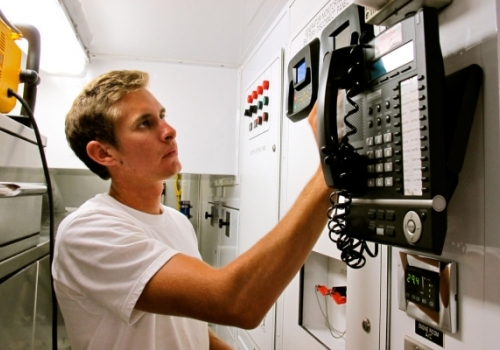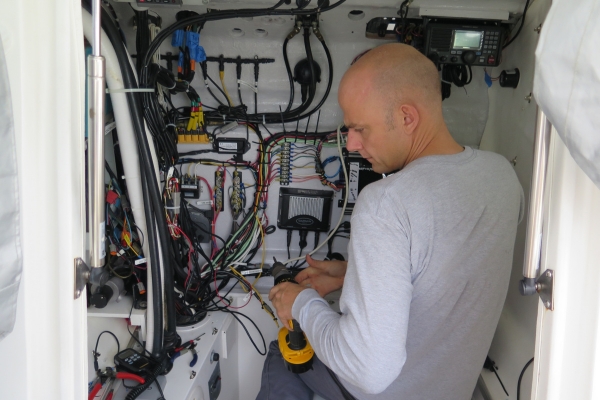A Guide to Superyacht ETO and AV/IT Careers

Following on from our guides on superyacht deck, interior, engineering and chef careers, it’s time to get technical and clear up some confusion around the roles of an ETO and an AV/IT officer. To keep us on track with the latest training requirements for both, we spoke to Scott Molloy of SEACertify to get his input for this latest guide courtesy of the careers guidance platform, Academy by Ephemeris.
What is the difference between the role of electro-technical officer (ETO) and that of superyacht AV/IT officer?
The AV/IT officer role generally encompasses interior automation, entertainment, IT and some satellite systems. Essentially, they oversee the technology systems beyond the remit of a traditional ETO, which is mainly marine electronics.
Before the Manila Amendments to STCW, superyachts interpreted the ETO role to include the ever-growing consumer technologies and IT on board, but it is now more important than ever to distinguish between the two roles.
In practice, an individual can fulfil either or both roles, however AV/IT has nothing to do with the role of the ETO - they are completely different.
What size of vessel would typically have both an ETO and an AV/IT officer?
Generally a superyacht longer than 90 metres almost always has a dedicated AV/IT officer. Below this length, a vessel is likely to have a crew member in another position assume the AV/IT role.
Whether the vessel has an ETO is less size related, but falls under two general scenarios:
-
Where the vessel has an ETO dictated on its Safe Manning Document (SMD). A flag state such as Cayman Islands is more inclined to ask for an ETO ticket amongst the crew when the vessel has diesel-electric propulsion, rather than the size of the vessel or the number of guests/passengers on board.
-
There is no ETO on the SMD, but the vessel/management have otherwise decided there is a crewmember with the job title ETO, as originally stated in the MCA’s MSN 1860 (now revised to MSN 1860 Amendment 1)
What qualifications do I need to become an ETO?
As for all crew working on board, to be a superyacht ETO you need to have completed your STCW basic safety training (a five day course) and have a valid ENG1 medical certificate.
The ETO’s remit was covered by a new Certificate of Competency (CoC) under regulation iii/6 of the STCW 2010 Manila Amendments. All crew sailing under the job title of ETO should now hold this ticket.
Paragraph 1.5 of The MCA’s MSN 1860 Amendment 1 states that: “If you are employed on a ship as an ETO, you must hold an STCW ETO Certificate of Competency whether or not an ETO is listed on the SMD (safe manning document)”.
How long is the training to become an ETO and what does it involve?
The standard route (without a higher education in Electrical Engineering or an equivalent Electro-Technical subject) is currently three years. A candidate requires sponsorship through a shipping company in order to complete five phases, split across college phases and sea time. The standard route leads to either a Foundation Degree or HND in Electronics and Marine Electrical Engineering.
All of the academic subjects, short courses and sea time required are offered within the route to enable a candidate to apply for a Notice of Eligibility (NOE). Once they have this, they can then sit the MCA Oral exam and gain their ETO Certificate of Competency (CoC) if successful.
Candidates must currently obtain at least 12 months of combined sea time and workshop skills, and have completed a Merchant Navy Training Board (MNTB) Training Record Book (TRB) while on board ship.
For those candidates with a higher level Electrical Engineering qualification or equivalent, there is now a fast-track cadetship route, which can take 18-20 months. This route is currently only being offered at South Shields Marine School. Candidates require sponsorship or approval from a shipping company to complete required sea and workshop time on this route.
Individual requirements vary depending on prior studies/sea time experience, which can be assessed by the Marine School. If eligible for this route, they can produce an action plan for a candidate to follow in order to obtain the required pre-requisites for their NOE. Once they have their NOE, they can then sit the MCA Oral exam and gain their ETO Certificate of Competency (CoC) if successful in passing the exam.

How do I progress through the ranks as an ETO?
Only some large superyachts are required to carry an ETO under their flag state’s safe manning requirements for the vessel. Other yachts may still choose to have an ETO to compliment their technical department. But with usually a maximum of one ETO on board some of the large yachts, there isn’t the same career progression on board you would see on larger vessels, such as cruise ships that have junior through to chief ETOs.
On superyachts, ETO career progression more often involves moving onto new positions with more responsibilities and an improved employment package on other vessels. In either case, it is essential to compliment the continuing on-the-job professional development with further short courses such as vendor-specific training or by gaining AV/IT skills also.
For those willing to gain an MCA SETO (Senior Electro-Technical Officer) endorsement in their CoC, this will assist in career progression also.
This can be obtained as follows:
-
12 months' sea time as an ETO with an ETO CoC
-
HND/Advanced Diploma, Foundation Degree or Degree in Electrical and Electronic Engineering
-
HELM(M) course completion certificate
-
High Voltage Management course certificate
-
Pass a SETO MCA oral exam
For more details on the SETO endorsement also see the MCA’s MSN 1860 Amendment 1.
With requirements in place for ETO certification, what is the current status for AV/IT training and certification?
A working group involving the relevant superyacht industry professional bodies and individuals has been developing a qualification framework for AV/IT training. This will result in crucial, yet non-mandatory, AV/IT training standards for the superyacht sector. The advantages include a new clear career pathway for superyacht AV/IT and also the creation of a new, easily recognised and industry-specific training standard. The most basic level of the qualification framework is close to launch, and once the independent assessment platform is finalised, may be completed within the next few months.
What is the working relationship between the ETO and the AV/IT officer?
On a vessel large enough to have both a dedicated ETO and AV/IT officer, they would both typically work under the chief engineer and be expected to assist each other as required, with some crossover of responsibilities possible. But most vessels are not large enough to have both as dedicated crewmembers, and they become roles. In these cases, the electrical/electronics role of the ETO and the technology role of the AV/IT officer fall to whichever other crew are deemed most suitable.
With thanks to Scott Molloy, Managing Director of SEACertify marine electronics training, and Spectral Marine, New Build AV/IT Consultancy.

Post your comment
You cannot post comments until you have logged in.
Login to post a commentComments
No one has commented on this page yet.
RSS feed for comments on this page | RSS feed for all comments